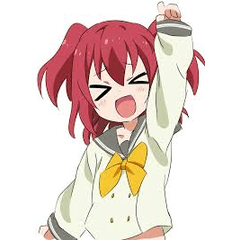Blending Modes: MULTIPLY, ADD (GLOW) & SCREEN
In this tutorial, I'll share my tips on how to achieve different values, interesting lighting and depth using the blend modes mentioned. Let's get to it!
Multiply
Multiply is the blend mode I often use to add shadows in the drawing. In this mode, any color you put into a layer adds tint to the layer below it, creating a new shade or combined colors. It kinda works like a cellophane sheet where everything you see from it becomes tinted with its color.
Notice how the areas where the two colors overlapped combined to produce a darker new color?
With that in mind, Let's apply it to the drawing we have below, starting from the shading.
Before we start, it's important to point out where our light source is so that the direction of the shadows go along with it. In this case, the light source is above the character. Generally, the shadows would appear in areas under and below the surfaces where light touches first.
After determining the light source, painting the shadows are done in Multiply. Since multiply layers automatically darken the colors by adding new ones on top of pre-existing hues, there's no need to use darker shades. Generally, I pick my shading color from this area in the color palette:
I used several layers on Multiply as the blend mode on top of the base colors to achieve some depth and define more details in the drawing. I played around with more hues. On top of the shadows, I also used a greenish gradient and set it to Multiply to make the character blend in more with the background.
And shading our character is done!
Add (Glow)
Any color that you apply on a layer that's on Add (Glow) makes that color brighter because it reduces contrast and intensifies brightness.
Using the same light source as our guide, I'll show you how to add highlights and enhance more details using Add (Glow).
We already determined the areas in which the light touch first, so they naturally have the strongest highlights.
The character doesn't look as gloomy, right? I also used Add (Glow) as the blend mode for the layers where the polished surfaces like the gold earring and the gem on her brooch reflect light, as well as adding strands of hair.
Blurring the colors applied in this blend mode will make highlights look like they're glowing~
Screen
I mainly use this blend mode as a support to enhance effects -- like using them for weaker light reflections, for instance, or to make the outer glow of shiny objects.
Now that we have our highlights, we'll now make the highlights "bounce off" using Screen.
Using Screen in support with the Add (glow) softens the image and makes it appear brighter. I also used this to enhance details, like applying them on the edges and defining depth on areas that are a little further away so it doesn't look too flat.
Using a yellowish color to depict sunrays, the weaker light rays were achieved using Screen.
Tada! It's nearly complete~ We'll add more details using the same three blend modes to polish off this piece.
Additional Effects
Using this mantra
Multiply = shadows
Add (Glow) = highlights
Screen = weak/low lights
we can create points of interest in the drawing and help to achieve a good ambiance, like how the drawing progressed from being flat, to gloomy to something fairytale-like. From here on, We'll just keep adding details using the same blend modes.
Front foliage = darker flat color, blurred then set to MULTIPLY
Light particles = droplets airbrush in ADD (GLOW)
Additional effects = hatch brush, blurred and set to SCREEN.
Good luck with that painting! Now go out there and start drawing~
























Comentario